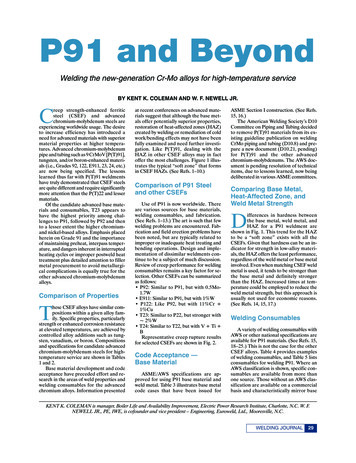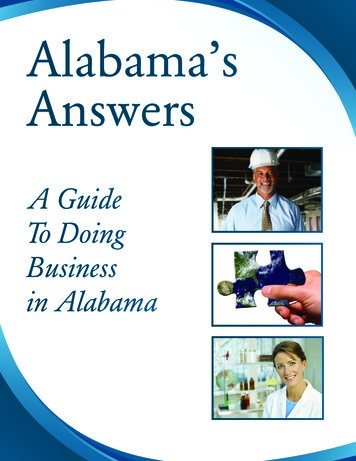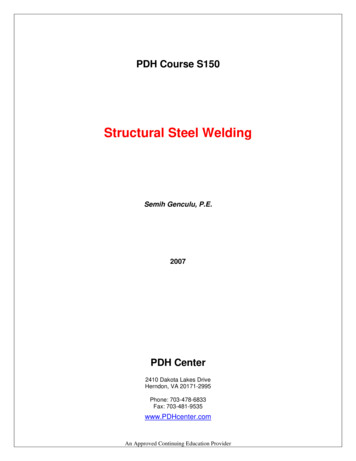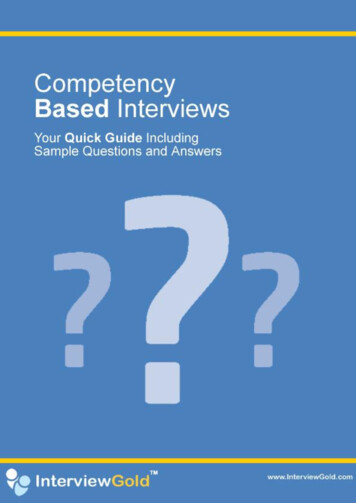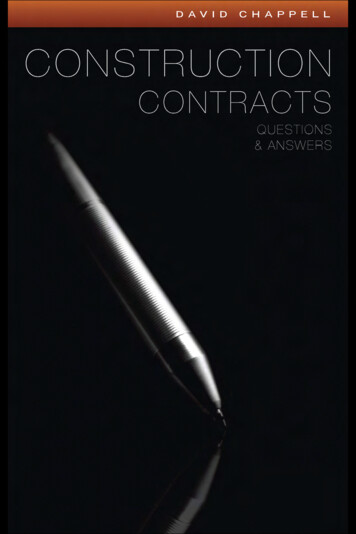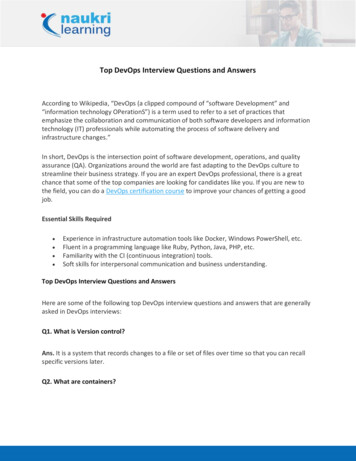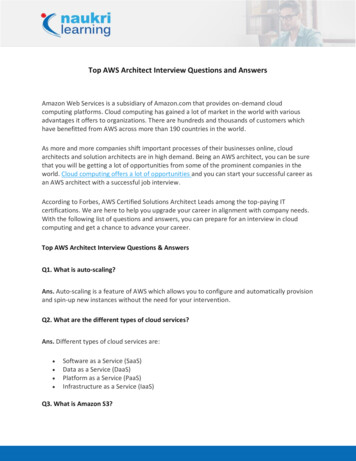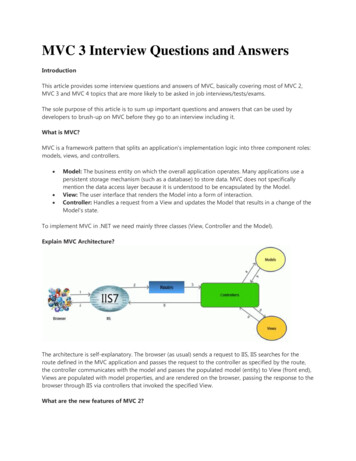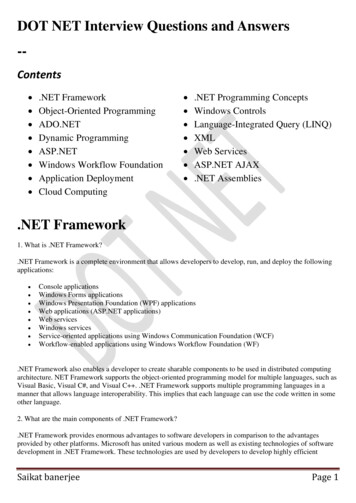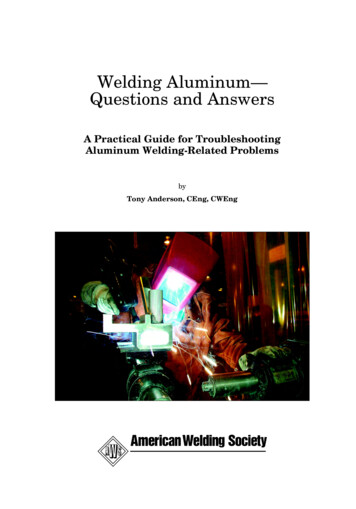
Transcription
Welding Aluminum—Questions and AnswersA Practical Guide for TroubleshootingAluminum Welding-Related ProblemsbyTony Anderson, CEng, CWEng
Welding Aluminum—Questions and AnswersA Practical Guide for TroubleshootingAluminum Welding-Related ProblemsbyTony Anderson, CEng, CWEngReviewed by theAWS Product Development CommitteeThis publication is designed to provide information in regard to the subject mattercovered. It is made available with the understanding that the publisher is not engagedin the rendering of professional advice. Reliance upon the information contained inthis document should not be undertaken without an independent verification of itsapplication for a particular use. The publisher is not responsible for loss or damageresulting from use of this publication. This document is not a consensus standard.Users should refer to the applicable standards for their particular application.550 N.W. LeJeune Road, Miami, FL 33126
WELDING ALUMINUM—QUESTIONS AND ANSWERSPrefaceThis book is largely comprised of individual Aluminum Questions and Answers thatwere originally published over a number of years in the American Welding Society(AWS) Welding Journal. The majority of the questions addressed herein originatefrom inquiries to me, primarily from individuals within the welding fabrication industry. Also included in this collection of material are some feature articles that I havehad published previously in the Welding Journal. The welding processes section contains some information and parameters graciously provided by The Aluminum Association and reproduced from their outstanding publication “Welding Aluminum Theoryand Practice.” Many of the graphics and charts within this book have been reproducedwith permission from ESAB Welding and Cutting Products and were taken frommaterial that is used by AlcoTec Wire Corporation and ESAB Welding and CuttingProducts for their aluminum welding technology training programs.This book is not constructed in the format that is typically associated with text bookspertaining to similar subjects. That is to say, because of the nature of the materialsource used for this book, the Aluminum Q&A columns, the individual chapterswithin this book have been compiled to best highlight and explain that material in amanner that reflects the original question and answer theme. For this reason the bookdeviates from the more traditional layout of a textbook, where typically you would seeall the information on specific topics grouped together more specifically.The idea for compiling this book originated through inquiries from individuals whofollowed the Aluminum Q&A column in the Welding Journal enthusiastically. Theywondered if anyone had ever thought of collecting all the information within the Aluminum Q&A columns together into a practical guide for troubleshooting aluminumwelding-related problems. I have tried to present this material in a logical format andhave included a fairly comprehensive table of contents in an attempt to direct thereader to their appropriate areas of interest. If the information contained in this publication helps individuals to better understand aluminum welding and possibly assistsin improving welding quality, then I will be pleased with the overall outcome.Tony Anderson, CEng, CWEngiii
WELDING ALUMINUM—QUESTIONS AND ANSWERSAbout the AuthorTony Anderson has 40 years of experience in the welding industry. He began his careerin 1968 when he joined Vickers Shipbuilding in Barrow-in-Furness, England as anapprentice welder. While working for Vickers Shipbuilding, predominantly employedon the welding of nuclear submarines, he attended technical college for four years andreceived the highest qualification at that time awarded by the City and Guilds of London Institute in Welding Engineering. In his late twenties, he relocated to SouthernAfrica where he spent 15 years employed as a Welding Inspector, Welding Engineer,NDT Manager, Quality Assurance Manager, and Welding Engineering Consultant.Anderson has also spent 15 years in the U.S. During this time he has been activelyinvolved with aluminum welding technology. He was employed by AlcoTec Wire Corporation where he held the position as Technical Director before being transferred toESAB Welding and Cutting Products as Corporate Technical Training Manager—ESAB North America.Mr. Anderson is the Chairman of the Aluminum Association Technical Advisory Committee for Welding and Joining and is associated with the following AWS Committees:AWS D10.7, Arc Welding of Aluminum Alloy Pipe (Chair)AWS A5.10, Bare Aluminum and Aluminum-Alloy Welding Electrodes and Rods (Chair)AWS A5.3, Aluminum and Aluminum Alloy Electrodes for Shielded Metal ArcWelding (Chair)AWS D3.7, Guide for Aluminum Hull Welding (Past Chair)AWS D8.14, Automotive and Light Truck Weld Quality—Aluminum (Past Chair)AWS D1.2, Structural Welding Code—Aluminum (Vice Chair)AWS Conference Committee (Vice Chair)Anderson has a Master of Science degree in Industrial Engineering Management andQuality Assurance and a Bachelor of Science degree in Welding Engineering. He isa Professional Member of The British Welding Institute (TWI) and a RegisteredChartered Engineer (CEng) with the British Engineering Council (EC–UK). He isan American Welding Society Certified Welding Inspector (CWI), Certified WeldingEducator (CWE), and Certified Welding Engineer (CWEng). He has had numeroustechnical articles relating to welding engineering published in many journals andmagazines over the years and has presented technical papers internationally at manyconferences and seminars. In 2004 Anderson was awarded the American WeldingSociety’s “Individual Achievement Award” in recognition of excellent service to theadvancement of the image of welding.v
WELDING ALUMINUM—QUESTIONS AND ANSWERSTable of ContentsSectionPagePreface. iiiAbout the Author.vList of Questions.xvList of Tables . xviiList of Figures. xviiiBasic Safety Precautions.xxiChapter 1—The Advancement of Aluminum within the WeldingFabrication Industry and its Many Product Design Applications.11.1 Introduction .11.2 Automotive Industry .11.3 Shipbuilding.31.4 Recreation and Sporting Equipment .41.5 Transportation and Containers .61.6 Defense and Aerospace.81.7 Conclusion .9Chapter 2—What is the History of Aluminum and Aluminum Welding?.112.1 Introduction .112.2 The Story Behind the Metal.122.3 Developments in Welding Aluminum.132.4 The History of Heliarc Welding (Gas Tungsten Arc Welding) .162.5 Gas Welding (Oxyacetylene Welding).172.6 Stick Electrode Welding (Shielded Metal Arc Welding) .182.7 Conclusion .18Chapter 3—Aluminum Alloys and Metallurgy .193.1 Introduction .193.1.1 The Aluminum Alloy Temper and Designation System .193.1.2 Wrought Alloy Designation System.193.1.3 Cast Alloy Designation .203.1.4 The Aluminum Temper Designation System .203.1.5 Aluminum Alloys and Their Characteristics .233.1.6 1xxx Series Alloys .233.1.7 2xxx Series Alloys .233.1.8 3xxx Series Alloys .243.1.9 4xxx Series Alloys .243.1.10 5xxx Series Alloys .243.1.11 6XXX Series Alloys .25vii
WELDING ALUMINUM—QUESTIONS AND ANSWERSSection3.23.33.43.5viiiPage3.1.12 7XXX Series Alloys. 253.1.13 Conclusion . 25What is the Affect of Arc Welding on the Heat-Affected Zone (HAZ) ofAluminum Alloys? . 263.2.1 Introduction. 263.2.2 The Various Types of Aluminum Alloys . 263.2.3 The Principal Effects of Alloying Elements in Aluminum. 263.2.4 Pure Aluminum 1xxx . 263.2.5 Copper (Cu) 2xxx. 263.2.6 Manganese (Mn) 3xxx . 273.2.7 Silicon (Si) 4xxx. 273.2.8 Magnesium (Mg) 5xxx. 273.2.9 Magnesium and Silicon (Mg2Si) 6xxx . 273.2.10 Zinc (Zn) 7xxx . 273.2.11 How Aluminum Alloys Obtain Their Strength . 283.2.12 Strain Hardening . 283.2.13 Heat Treatment. 283.2.14 The Affect of Arc Welding on the Heat-Affected Zone . 283.2.15 Nonheat-Treatable Alloys. 303.2.16 Heat-Treatable Alloys. 303.2.17 Conclusion . 30Is There a Filler Alloy that Can be Used to Weld All Aluminum BaseAlloys, and How Do I Weld Aluminum Alloys 7075 and 2024? . 313.3.1 A Filler Alloy for All Aluminum Base Alloys. 313.3.2 Welding 2024 and 7075. 323.3.3 Conclusion . 33What are the Differences Between the Heat-Treatable and NonheatTreatable Aluminum Alloys?. 333.4.1 Understanding the Basic Differences Between Heat-Treatableand Nonheat-Treatable Aluminum Alloys. 333.4.2 Nonheat-Treatable Aluminum Alloys . 333.4.3 Heat-Treatable Aluminum Alloys . 343.4.4 How Does the Type of Material, Heat-Treated or Nonheat-Treated,Affect the Completed Strength of the Weld? . 343.4.5 Conclusion . 35What are the Alloying Elements in Aluminum Alloys? . 353.5.1 The Addition of Alloying Elements to Aluminum . 353.5.2 The Principal Effects of Alloying Elements in Aluminum. 363.5.2.1 Copper (Cu) 2xxx. 363.5.2.2 Manganese (Mn) 3xxx. 363.5.2.3 Silicon (Si) 4xxx. 373.5.2.4 Magnesium (Mg) 5xxx .
were originally published over a number of years in the American Welding Society (AWS) Welding Journal. The majority of the questions addressed herein originate from inquiries to me, primarily from individuals within the welding fabrication indus-try. Also included in this collection of material are some feature articles that I haveFile Size: 521KBPage Count: 20

